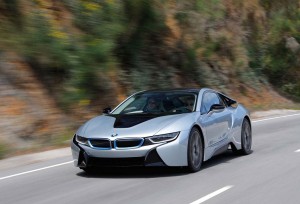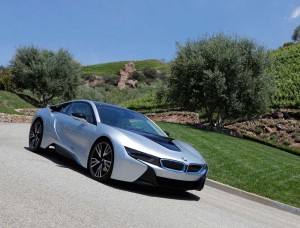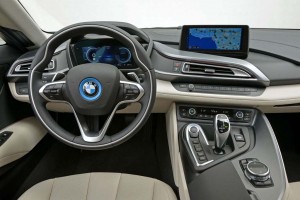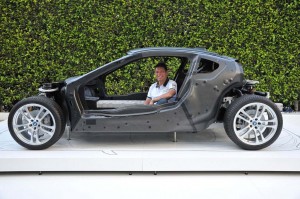
BMW's i8 plug-in hybrid sports car is expected to roll off the production line this summer with the first deliveries in Europe.
The BMW i8 may look more like a concept than a production car, but it really is street legal. BMW’s first plug-in hybrid sports car has just begun rolling down the maker’s assembly line in Leipzig, Germany, and will soon join the i3 city car as the foundation of an all-new, brand-within-a-brand of battery-based vehicles, collectively known as BMW i.
The appeal of the i8 is not just in it’s distinctive, carbon-fiber skin. Beneath that futuristic body, the i8 boasts game-changing technology that could revolutionize the sports car segment – a good reason for TheDetroitBureau.com to head off for some time behind the wheel before it officially goes on sale next month in Europe.
One thing is certain, the i8 has to live up to some grand expectations. Sales of the plug-in sports car have already exceeded BMW’s original forecast, so the Bavarians have decided to ramp up production. Exactly how many will it sell? BMW isn’t saying for sure, though it’s expected this year’s production will run between 3,000 and 3,500 units.
It is no secret that the North American market is likely to make up 25% of total sales, with another 20% earmarked for Germany and 12.5% for the U.K. The remainder will go to the Middle East, China and a number of smaller markets, including European countries.
If current trends hold, the vast majority of demand in the U.S. will come from just Southern California, and according to a major dealer in the region, customers ordering now will have to wait a year before they will get their car. The first BMW i8 delivered to the U.S. won’t be handed over to its new owner until the Pebble Beach Concours d’Elegance in August.
To be honest, our expectations were a little guarded as we got the key for our pilot model considering the less-than-stellar reception given to the i3, the first model from BMW’s battery brand. The i3 may find plenty of buyers in urban settings, but its road dynamics are clearly not what a traditional BMW fan would anticipate.
It turned out we had little reason to worry about the i8. During our first laps in a prototype at BMW’s test track in southern France it was clear that this car may be able to bring the driver pretty close to ecstasy.
That said, it can be a challenge to provide optimal performance between the i8’s electric motor and its two-speed transmission with the 1.5-liter three-cylinder turbo gas engine with its own six-speed automatic, acknowledged BMW’s “chassis guru” Jos van As.
But as he readily demonstrated, once everything was set up right, it became easy to deliver a classically BMW sporty ride – even to put the i8 into a controlled drift.
We had additional time on public roads in Southern California, taking the i8 for a jaunt down the scenic – but challenging – Mulholland Highway cutting through the Santa Monica Mountains.
(GM engineer involved in switch recall retires. For more, Click Here.)
The i8 proved to be well prepared with the 131 hp electric motor that drives the front wheels and the 231 hp inline-four pushing power out to the rear wheels. Anyone who thinks battery cars are slow and ungainly – Chevy Volt anyone? – will likely experience a quick attitude readjustment when they spend time in the i8.
For one thing, the car accelerates from 0-100 kmh – 0 to 62 mph – in just 4.2 seconds, a figure that handily matches up with many well established sports cars on the road today. With a combined torque of 420 pound feet (184 for the electric motor and 236 for the gas-powered engine), power is readily available. Of course, it’s not just about raw launch power. But both on track and on the canyon roads near L.A., we quickly discovered that this 3,372-pound sports car lives up to BMW’s “fun-to-drive” expectations.
Unlike the pure battery-electric i3, the BMW i8 blends battery and electric propulsion, a decision that helps it minimize the mass of lithium-ion batteries that humbles the driving experience of the little city car. The sports car carries a modest 7.1 kilowatt-hour pack, though only 5.1 kWh are actually used during normal driving in order to maximize battery life.
The i8 offers a driver the option to set up for a variety of different driving situations. That includes eMode, operating purely on battery power for a maximum of some 22 miles at a speed up to 75 mph. The i8 always starts in Comfort mode, but when you push hard on the throttle the three-cylinder engine wakes up.
(Click Here for TDB’s first drive in the Mercedes B-Class EV.)
The transitions from from one mode to another in our pre-production test car were not perfect, but according to the i8 project leader Carsten Breitfeld, this is being fine-tuned before the first models actually reach showrooms.
Some might question the relatively short distance the i8 can travel on battery power alone. But BMW claims that with the possibility of getting an 80% recharge in less than 2 hours at a 3.7 kW charger at the office or the mall that range will be enough for the 25 miles the typical driver is likely to log in a day. The combined range, using both battery and electric, is expected to be around 310 miles.
The consumption in the European Cycle is 2.1 liter per 100 km, which translates into 112 mpg with 49 grams of CO2 emission. Electric power in addition to fuel consumption is stated as 11.9 kWh/100 km (62 miles). The EPA figures are due soon, but traditionally they run about 25% less than the European numbers.
The small battery pack has been tucked as low as possible into the lightweight carbon fiber chassis to improve the vehicle’s center of gravity. Aluminum subframes, meanwhile, support both the suspension and powertrain. And the aerodynamically tuned body itself is made of lightweight plastic panels that further reduce mass.
The body and chassis construction is as significant as the complex powertrain itself and could be an indication of where the auto industry is going in the future as manufacturers struggle to meet tough new emissions and mileage standards – including the 54.5 mpg CAFE rules that will go into effect in 2025.
(To see what GM CEO Mary Barra told U-M graduates, Click Here.)
We’re beginning to see a lot more use of aluminum – even Ford is going with this light metal for the body of its 2015 F-150 pickup – but until now, carbon fiber has largely been limited to applications on the race track and a handful of Ferraris, McLarens and other exotic sports cars. BMW has invested heavily in a carbon fiber project that could help lead the way to transform the strong but lightweight material into something ready for the mass market.
Though it doesn’t operate as a full-time battery-car, the BMW i8 is likely to provide an interesting alternative to upscale buyers who want to drive something green but still want something sporty and luxurious. Will it be the next big thing, an alternative to the Tesla Model S that has become a West Coast status symbol of late? We should begin finding out by this time next year.
Oh, and at $135,000, the i8 carries a hefty premium compared to the Tesla, a fully loaded Model S coming in at a mere $110,000.



